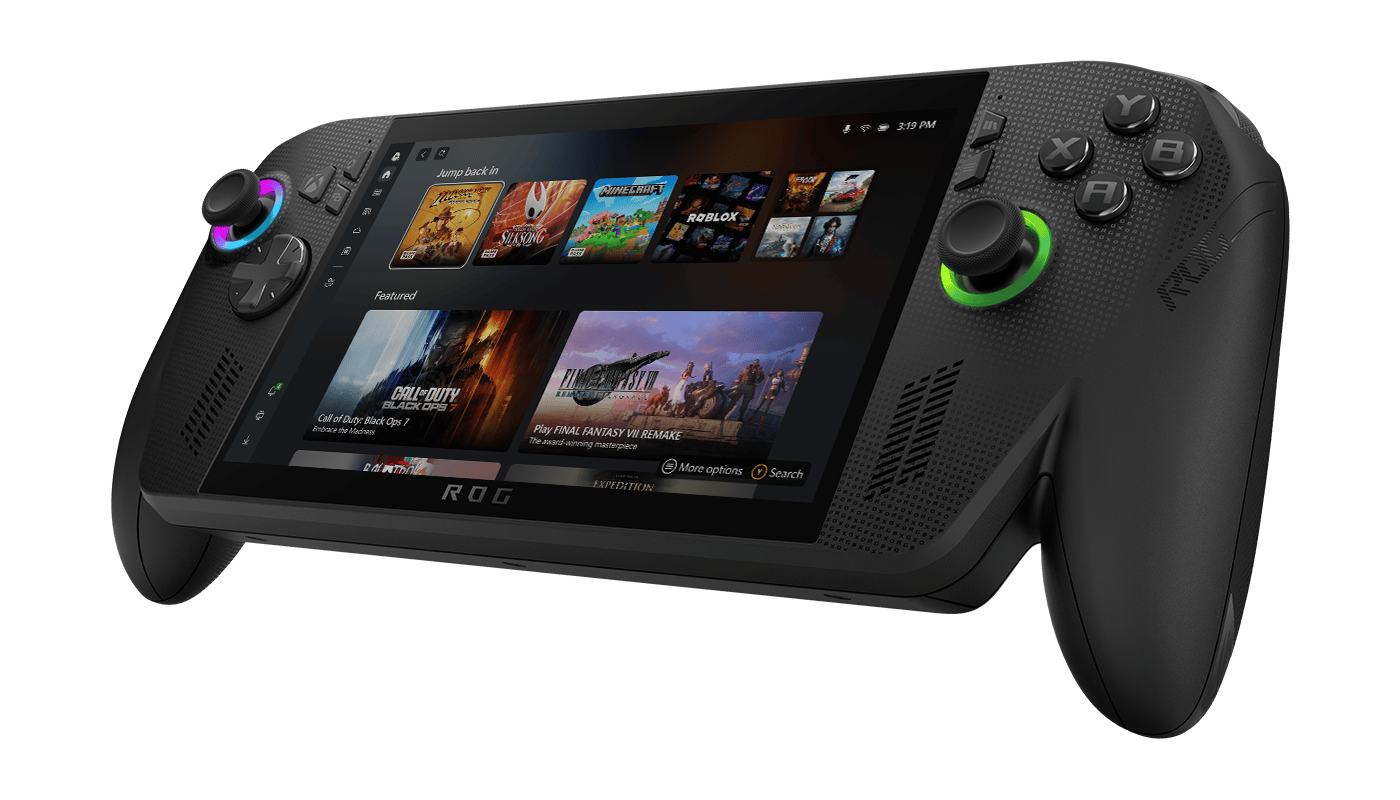Main Navigation Menu
© 2025 Tech Jacks Soutions, All Rights Reserved
© 2025 Tech Jacks Soutions, All Rights Reserved
ROG Xbox Ally scalping nightmare erupts as supply chain issues let resellers ask for over $2000 for the already overpriced $999 handheld from Microsoft and ASUS. The Shortcut reports ASUS ROG Xbox Ally X scalpers are asking for crazy amounts of money, with some listings exceeding $2500 for hardware already priced beyond mainstream accessibility. The artificial scarcity, combined with port congestion and corporate finger-pointing, creates a perfect storm where legitimate consumers cannot obtain devices at a reasonable price.

PCMag confirms ASUS can’t ship enough product to the US due to backed-up ports, creating supply shortage that scalpers immediately exploited. The ROG Xbox Ally scalping Nightmare turns an already questionable $999 value proposition into a $2000-$2500 luxury. item accessible only to desperate enthusiasts with disposable income.
Reddit’s ROGAlly community documents Microsoft and ASUS opening Xbox Ally preorders with X costing $999, immediately selling out to bot networks and professional resellers. The immediate inventory depletion indicates either intentionally restricted supply or a total underestimation of scalpers’ advanced tactics targeting high-margin electronics.
The scalping markup exceeds 150% over retail, creating a secondary market where ROG Xbox Ally costs more than gaming laptops that offer better performance and versatility. When handheld devices are priced like desktop units due to artificial scarcity, it exposes fundamental supply chain failures or intentional shortages.
The port congestion excuse seems convenient, especially since ASUS can supply other products while the ROG Xbox Ally remains perpetually unavailable. The scalping chaos surrounding the ROG Xbox Ally benefits ASUS by fueling perceived demand, while they avoid accountability for fulfilling actual market needs.

Tech4Gamers reveals Microsoft & ASUS allegedly tried to lower ROG Ally X price after fan backlash but plans collapsed during negotiations. The ROG Xbox Ally scalping nightmare worsens as companies can’t agree on pricing while scalpers exploit supply shortages.
GamingBolt confirms Microsoft and ASUS tried to reduce ROG Xbox Ally pricing according to rumors, suggesting both companies recognize pricing problems but cannot coordinate solutions. The negotiation failure reveals partnership issues where neither side takes responsibility for market positioning problems.
The sudden price reduction exposes deep disagreement over hardware value and market positioning. When partners can’t agree on basic pricing strategies, the ROG Xbox Ally scalping issue becomes unavoidable as unclear messaging allows opportunistic reselling at any price desperation permits.
Launching negotiations after release rather than before shows a reactive instead of proactive approach. Companies apparently realized $999 price resistance only after facing market rejection, indicating they were out of touch with consumer reality during product planning.

Inkl reports Microsoft claiming “it really was ASUS” regarding ROG Xbox Ally X’s eye-watering $1,000 price tag, deflecting responsibility for pricing decisions. The ROG Xbox Ally scalping nightmare involves a corporate blame game where partners publicly undermine each other instead of fixing supply failures.
PCWorld documents Microsoft pointing finger at ASUS for ROG Xbox Ally’s hefty pricing, creating public relations disaster where partnership discord becomes visible. The finger-pointing exposes a deeper strategic misalignment, with Microsoft favoring accessible pricing while ASUS aims for a premium market position.
TechRadar observes Microsoft attempting to distance itself from ROG Xbox Ally pricing fiasco as supply leaks highlight problems. The distancing strategy indicates that Microsoft recognizes brand damage from being linked to overpriced, unavailable hardware controlled by scalpers.
Public blame assigns damage to partnership credibility when consumers lose faith in both companies’ ability to provide functional products at fair prices. The ROG Xbox Ally scalping nightmare becomes less important compared to the reputational harm caused by corporate infighting.
TechRadar celebrates in world of obscene handheld gaming PC prices, Valve drops major Steam Deck LCD discount, highlighting competitive contrast. The ROG Xbox Ally scalping nightmare makes Steam Deck’s $399-$649 pricing seem reasonable by comparison.
Valve’s timing with discounts appears strategic, taking advantage of ROG Xbox Ally shortages and pricing issues. When competitors struggle to supply their products at any price, Steam Deck’s quick availability at lower costs offers a clear advantage.
The discount on the Steam Deck’s LCD to $349 for the base model is less than the markup of a scalped ROG Xbox Ally alone. This scalping nightmare supports Valve’s approach of prioritizing accessibility over maximizing profit.
The price comparison becomes even more striking when a $349 Steam Deck provides a gaming experience comparable to a scalped ROG Xbox Ally costing over $2000. When platform makers set fair prices, they gain customer loyalty — a benefit that Microsoft and ASUS’s greed seem to ignore.

Tom’s Guide’s review praises ROG Xbox Ally X hardware while acknowledging ecosystem failures that compound value problems. The ROG Xbox Ally scalping nightmare makes positive reviews meaningless when consumers can’t buy products at the reviewed prices.
The review points out performance improvements and battery life upgrades that justify high prices on their own. But when scalpers control stock, the technical advantages become irrelevant to real purchasing decisions.
The ecosystem criticism involves Windows complexity and Xbox integration issues that limit usefulness. The ROG Xbox Ally scalping problem means early buyers pay over $2000 for a beta-like experience that should cost half as much even retail.
Professional reviews can’t reflect the scalping reality where a device with a theoretical $999 price ends up costing over $2000 in practice. When market chaos blocks normal buying, the review system no longer matches the consumer experience.

ASUS’s explanation for port congestion causing supply failures seems suspiciously selective, especially when considering the availability of other products. The scalping chaos surrounding the ROG Xbox Ally suggests either targeted supply restrictions or logistical incompetence specific to high-demand items.
The port delay affects all manufacturers, yet Sony, Nintendo, and Valve maintain reasonable stock levels. When competitors handle similar challenges successfully, ASUS’s failures point to organizational problems rather than external issues.
The supply chain excuse allows ASUS to avoid accountability for underproduction or allocation decisions that favor certain markets. The scalping issues with the ROG Xbox Ally benefit ASUS through the illusion of scarcity, while legitimate consumers face availability problems.
Port congestion cannot account for a month-after-month shortage unless ASUS intentionally under-ordered expecting low demand. The ongoing unavailability hints at either major forecasting errors or deliberate scarcity creation to enable premium positioning.

The ROG Xbox Ally scalping nightmare highlights a complete ecosystem failure, where $999 overpriced hardware becomes a $2000+ scalper commodity due to ASUS supply incompetence and Microsoft partnership dysfunction. Artificial scarcity allows for 150% markups, making an already questionable value proposition completely untenable.
Port congestion excuses are hollow when competitors maintain inventory despite similar logistics challenges. ASUS’s selective shortage affecting only high-demand products suggests deliberate constraints or major forecasting errors rather than external factors.
Failed price reduction negotiations expose partnership failure, with Microsoft and ASUS unable to coordinate basic strategies while scalpers maximize profits. The post-launch response shows reactive scrambling instead of proactive planning that considers market realities.
Microsoft’s public blame on ASUS damages partnership credibility while attempting damage control for brand association with overpriced failure. This blame game reveals strategic misalignment, with companies pursuing incompatible goals at the expense of consumers.
Steam Deck’s discount timing capitalizes perfectly on ROG Xbox Ally chaos, offering $349 immediate availability against $2000+ scalped competitors. Valve’s pricing sanity makes Microsoft and ASUS look exploitative by stark contrast—respecting consumers versus extracting maximum gains.
Tom’s Guide praise becomes meaningless when positive hardware reviews pertain to unavailable products costing double through scalpers. The gap between media assessments and market reality reveals a systemic failure in the media ecosystem that should acknowledge actual consumer experience.
Supply chain incompetence, whether intentional or accidental, creates market dysfunction where scalpers become the primary beneficiaries. The ongoing shortage suggests ASUS either cannot or chooses not to address availability issues that turn products into speculative commodities.
The partnership breakdown between Microsoft and ASUS indicates a doomed product with no clear strategy or execution capability. When both companies publicly blame each other while scalpers control inventory, the ecosystem failure becomes irreversible.
Smart consumers should see the ROG Xbox Ally scalping nightmare as validation to avoid this cursed product altogether. Amid corporate dysfunction, scalper exploitation, and better alternatives, there’s no rational reason to participate in this failing ecosystem.
Gaming deserves accessible hardware at fair prices, not artificial scarcity that enables scalper parasitism. The ROG Xbox Ally nightmare demonstrates how corporate greed and incompetence cause market failures, with resellers profiting and legitimate consumers suffer.
